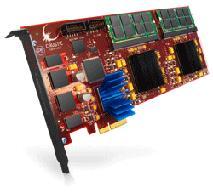Caustic Promises 200x Boost in Raytracing by 2010
Caustic Graphics, a small startup out of San Francisco, is promising exponentially faster raytracing as early as next year. Founded by a group of former Apple engineers, the new company is touting its CausticOne graphics accelerator card as the solution to the sluggish raytracing techniques currently available.
For years, the rendering option of choice for the gaming industry has been rasterization. Raytracing is a wholly different approach, which holds promise for more realistic graphics. The trade off with raytracing is that it requires much more processing muscle than rasterization.
Intel has been one company behind raytracing, but its demos are completely reliant on the current CPU/GPU setup. The tech giant's position on raytracing is that its CPUs can handle raytracing while also handling other general purpose duties. Caustic says its CausticOne card can give a 20x speed boost to raytracing, and "uses a host of new raytracing technology and algorithms to off-load raytracing calculations and prepare data for your GPU/CPU." By the end of 2010, the company claims that number will be up to 200x.
On the software side of things, CausticGL is a new API based on OpenGL that includes raytracing extensions, allowing for such techniques to be readily available to game designers.
While Caustic will be ready with its hardware and software sometime next year, the question is will the masses be ready for such an add-in card? In order for the tech to catch on, it will need adoption by both consumers and most game developers (or at least the big ones). Plus, with high end gaming PCs already costing an arm and a leg, the addition of a $xxx Caustic card may not be seen as a prudent investment by some. PhysX tried the add-in card approach for game physics, but the technology never caught on until the company was bought by Nvidia and the technology was integrated in the company's graphics cards.
While raytracing gives games a fresh look, and is indeed promising, rasterization is by no means looking old. Sure, Quake 4 may look good with raytracing, but it may take another couple of years for the technology to catch on.
Get Tom's Hardware's best news and in-depth reviews, straight to your inbox.
-
horendus With any luck this will take the same path as Physx...and be bought out by a graphics card maker, to have the API be implemented into graphic cards.Reply
or even better, have parts of the e card integrated into a GPU -
Watch this space, ray tracing is on its way, this may not be the definitive product, but its a starting point and one which is very welcomed.Reply
As all our components get faster we step closer to the power unleashed by ray tracing and the level of detail and realism it can provide in many applications from image manipulation to movie production and gaming especially :) -
Watch this space, ray tracing is on its way, this may not be the definitive product, but its a starting point and one which is very welcomed.Reply
As all our components get faster we step closer to the power unleashed by ray tracing and the level of detail and realism it can provide in many applications from image manipulation to movie production and gaming especially :) -
KyleSTL "Apple Engineers"Reply
Would you buy a Dell-design GPU? Or a Microsoft-developed CPU?
As far as computer hardware is concerned Apple engineering seems like kind of a joke. All that Apple does for computers is make an OS to load into existing equipment made by hardware companies (Intel, nVidia, etc). Apple doesn't even manufacture the iPod, that's at least assembled by HP, and I wouldn't be surprized if they designed the hardware too, and Apple just made a pretty mobile OS to run the device. -
srbruno Crack open any Apple case and have a look at apple's engineers. You think software guys came up with the macbook air? Apple designs everything they make, but yes you are sorta correct, they don't manufacture it.Reply
-
curnel_D KyleSTL"Apple Engineers"Would you buy a Dell-design GPU? Or a Microsoft-developed CPU?As far as computer hardware is concerned Apple engineering seems like kind of a joke. All that Apple does for computers is make an OS to load into existing equipment made by hardware companies (Intel, nVidia, etc). Apple doesn't even manufacture the iPod, that's at least assembled by HP, and I wouldn't be surprized if they designed the hardware too, and Apple just made a pretty mobile OS to run the device.You need to read a little more. Your entire post is a waste of time.Reply -
sacre Help me guys, Ray-tracing is another form of processing graphics, but the quality is what, better then the conventional? but requires so much more processing power? Is there really a huge diff between the two? because the vids i've seen it just shows reflections which is already being done on the conventional.. i'm not sure what to see hereReply -
evilshuriken Sacre,Reply
ray tracing generates very realistic lighting. Rendering techniques such as global illumination, final gathering, sub surface scattering, caustics, all are products of ray tracing.
